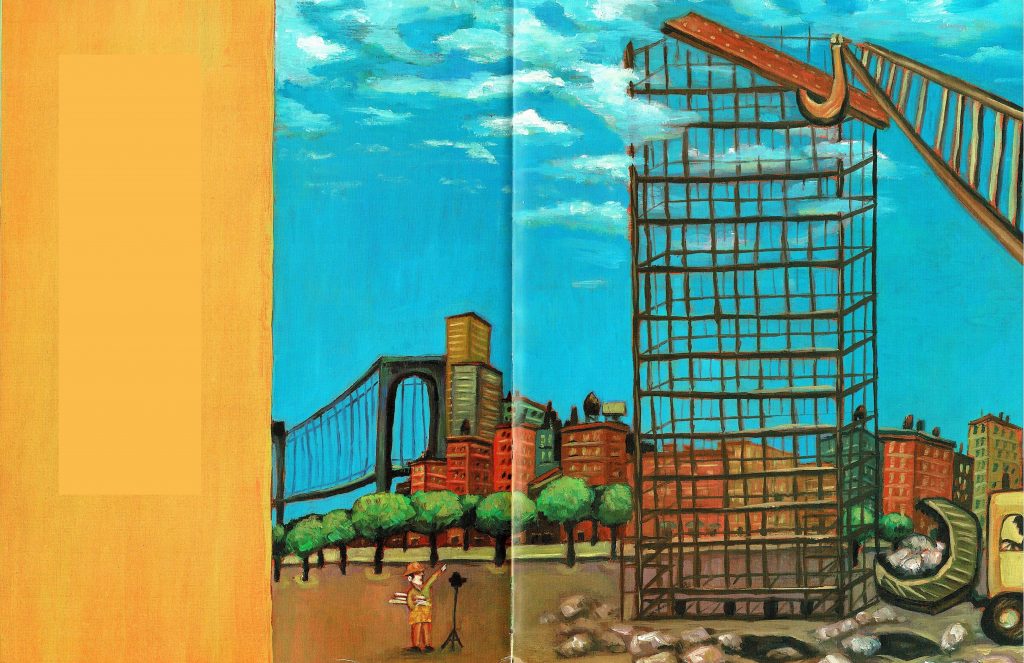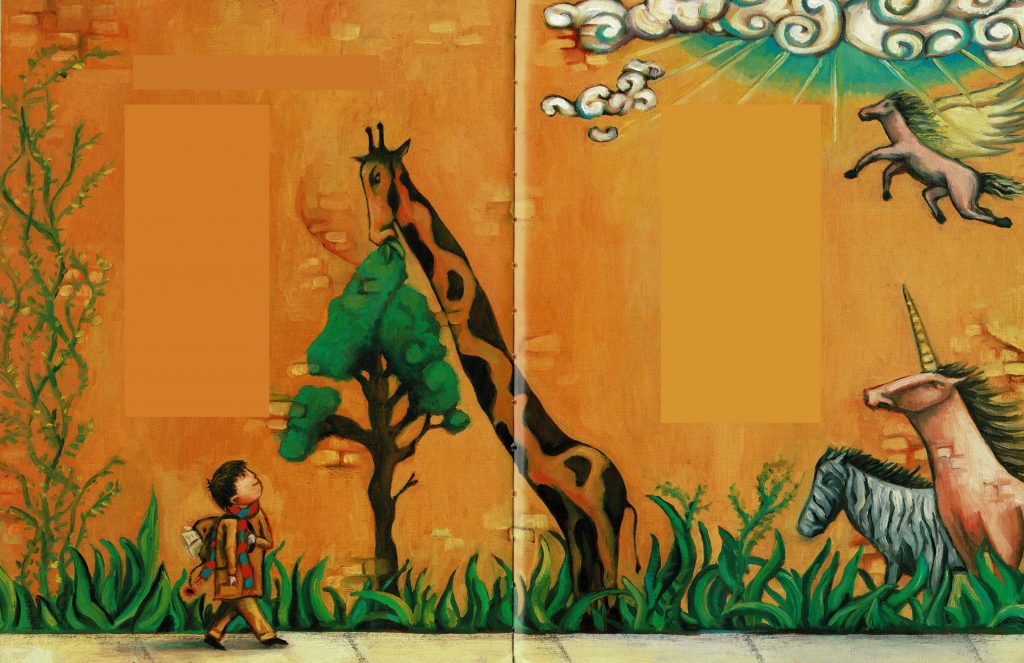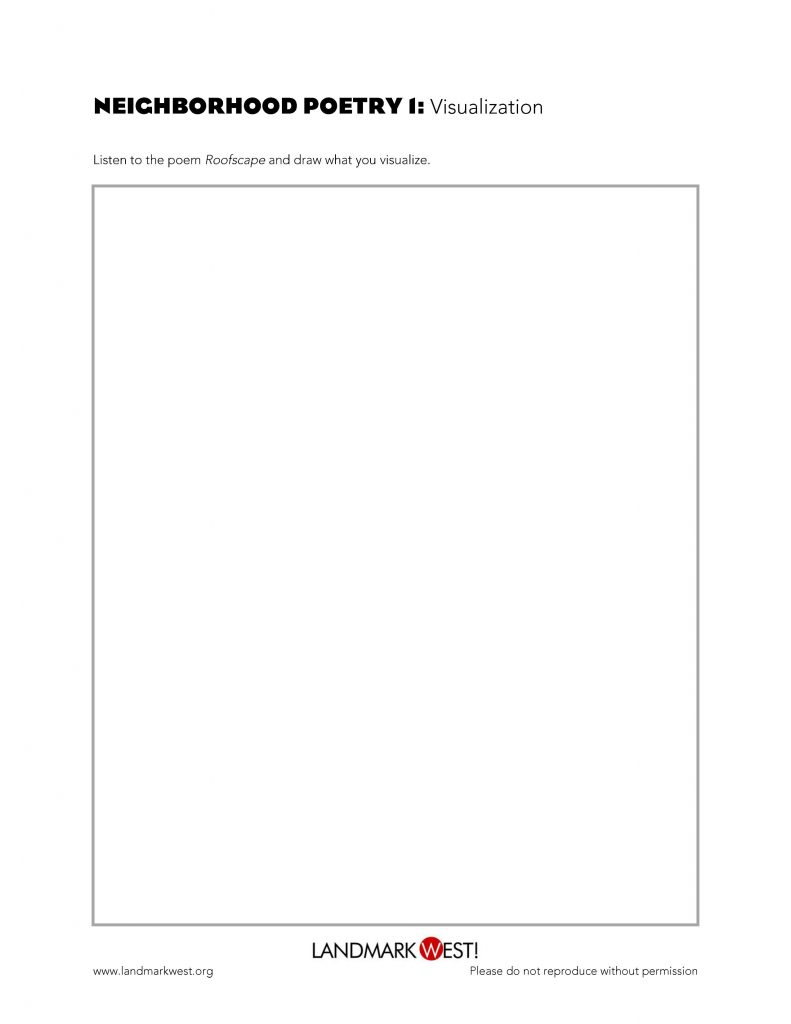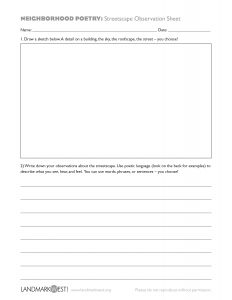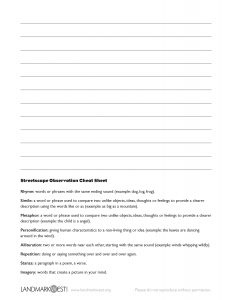Neighborhood Poetry @ Home
Simply click the menus below to access additional information. You can find our full lesson plan here.
Urban Poetry & Visualization
 Today we will be thinking about how poets write about buildings and neighborhoods in much the same way that an artist might draw or paint a scene on a city street.
Today we will be thinking about how poets write about buildings and neighborhoods in much the same way that an artist might draw or paint a scene on a city street.
You may have already learned about poetry in your classroom, and some tools that you can use in poetry. You may know that there are many different types of poems – acrostic, limerick, a concrete poem, haiku or a cinquian – are some you may already be familiar with.
For this program we will be focusing on sensory poems. A sensory poem describes how a poet perceives what something looks like, tastes like, smells like, feels like, and sounds like. We are going to use what we see around us as our inspiration, and we will start by using poems and illustrations by Lillian Moore from her book Mural on Second Avenue. Her poems speak to the joys and everyday wonders of city living, and they are brought to life with illustrator Roma Karas’s simple, vibrant pictures. We will use them to think about how to create an image through language – visualization.
Below is our first picture.
What do you see in the picture?
What clues can we see in the picture that tell us what the poem might be about?
What might the title of the poem be?
You might have noticed the city setting, the bridge in the background, the bulldozer and crane, the steel frame of an unfinished building, and a construction worker on the ground.
Click this link to read the poem and see what it is about.
What did you like most about this poem? Did you notice the poetry tools it used – the machinery is personified as a mouth chewing and arm lifting, the first two stanzas end with a rhyme in the last line and the comparison words it uses – giant vs. tiny.
Let’s try this picture too.
How about this picture? What does it make you think of? Is it real?
What clues can we see in the picture that tell us what the poem might be about?
What might the title of the poem be?
Do you think that the child in the photo is walking through a zoo or jungle looking at giraffes, zebras, and unicorns? Or did you notice the sidewalk and the outlines of bricks apparent in the background, and thought that maybe this is a mural painted on a wall?
Click this link to read the poem and see what it is about.
What language stands out as poetic? Did you notice the poem descriptions – “dreaming to the slap of a wet brush”, “unwindowed wall”, “a sky of eye-blinking blue”. What are each of these referring to?
What if we now listened to the poem, and drew what we visualized?
Let’s try it out. The poem in the recording below is Lilian Moore’s poem ‘Roofscape’. Before listening, what do you think “roofscape” might mean? Compare it to “landscape” or a “streetscape”. As we learned with ‘Construction’ and ‘Mural on Second Avenue’, the title of the poem often gives us clues as to what the picture will be. If you’re still stuck, try this definition.
Listen to the poem several times, and visualize what the words mean. What do you imagine when you are listening to it.
Once you have listened to the poem, draw what you are visualizing. If you have a printer, you can print our worksheet below. If not, just use a blank piece of paper!
Before you start to draw, think about some of the words in the poem – they give you clues about where the poem might be written from (the view), and what you might be seeing.
Would you like to see the picture from the book? Click here! How did it compare to your picture?
If you’d like to, you can share them with us here at LandmarkWest! at education@landmarkwest.org or on social media using the hashtag #kpf @landmarkwest.
Observation
Using our experiences we learned with ‘Visualization’, we will now write down our own observations of our neighborhoods.
Typically we sit outside for twenty minutes (or more!) and listen to the sounds of the city, observe nature, and admire the buildings around us. We may venture to Central Park West to do this, and inevitably write about the buildings that grace the street, or the sounds of Central Park behind us, or the patterns we see on the sidewalks and benches we are sitting on. We may walk to the West Side Community Garden and, at this time of year, enjoy the budding tulips and fields of flowers, watch the buzzing bees fly by, and relish the peace and quiet we find in small places in this chaotic city.
Before we PAUSED school in March, the 2nd grade students of PS166 ventured to ‘observe’ the concrete horses sculpted by Constantino Nivola at the Stephen Wise Towers Plaza between West 90th and West 91st Streets. Here the students not only wrote about the surrounding buildings, but also the murals and artwork through the Plaza, and the texture and playfulness of the horses. They ‘rode’ the horses, made up stories, and we talked about how when the were originally installed, the horses were colored red, blue and yellow! Below are some pictures we took that day.
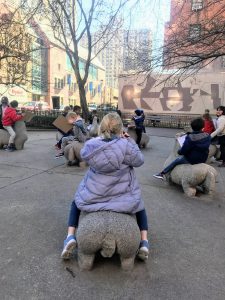
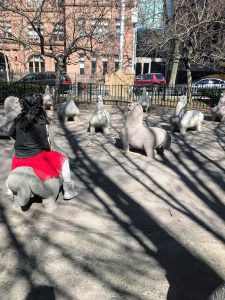
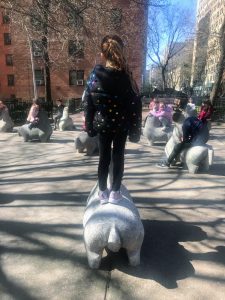
Now it’s your turn! You can print out our worksheets below, or use your own paper.
Here are some instructions and ideas to get you going:
- You can do this inside as well as you can outside, perhaps just open the window a little as you think and write.
- It doesn’t matter if you draw or write first – most people draw and then describe their picture, but do whichever you like first.
- When writing, you can do ANY of the following – write a poem, write a story, write short sentences, write in ‘dot points’, or a combination of all of these.
- Remember to get in touch with your senses, and write about what you’re seeing, hearing and feeling, and what you’re reminded of.
- Use the poetry tools we included earlier – there’s a ‘cheat sheet’ too on the worksheet if you need a reminder.
And some prompts if you need a little extra help:
- Describe what it’s like.
- Look at the clouds. Or the flowers.
- How many colors do you see? Are they all the same?
- Write down all the sounds you hear.
- Write from the point of view of an animal or plant. Pretend you’re a butterfly.
- Use all five senses.
- I know it’s Spring when…
- How tall are the buildings? Can you see other people or windows? What are they built of?
If you’d like to, share your picture and writing with us here at LandmarkWest! at education@landmarkwest.org or on social media using the hashtag #kpf @landmarkwest.
Group Poetry
Notes: in our current online learning environment, group work is likely more difficult than in the classroom. Here are our suggestions for this activity:
- If all students complete and submit the ‘Streetscape Observation’ activity to you, retype a line or two from each students work, and give each group, or individual student, 5 or 6 lines to create a new poem with. Alternatively, send them to us and we’ll retype and manage them for you!
- Use the lines written by PS166’s 2nd graders in March: Group Poetry examples (or Group Poetry examples in Google Doc format) and cut, paste and mix up as you like.
Follow these steps to create your poem!
- Choose (or be given) 5 or 6 lines of writing.
- Order the lines as you would like – you’re creating your own poem!
- Read them aloud to see if you like it, or need to make changes.
- Once you’re happy with it, paste or write the lines on a larger sheet of paper.
- Create your own title and write it up the top. Remember what we learned earlier about titles and what they tell you about the poem.
- If you like, add additional decorations, borders and details.
- Share! If you’d like to, share your picture and writing with us here at LandmarkWest! at education@landmarkwest.org or on social media using the hashtag #kpf @landmarkwest.



More Workshops

To inquire about having your school partner with Keeping the Past for the Future, please contact
Shannon Hill LANDMARK WEST! education@LandmarkWest.org
45 West 67th Street New York, NY 10023

